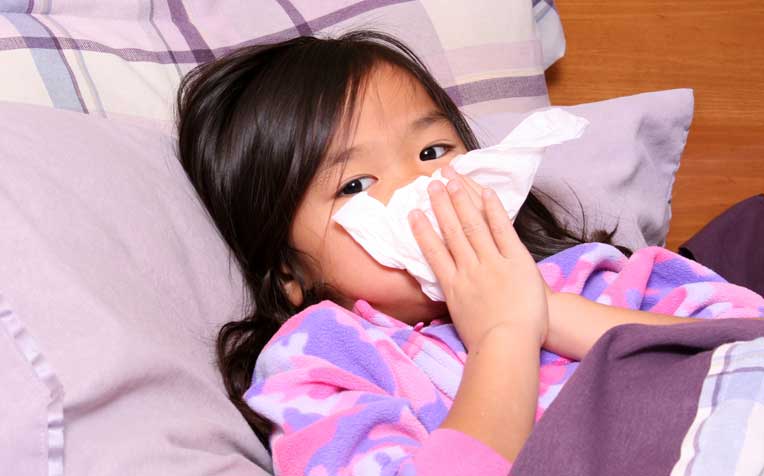
Keep a lookout for symptoms such as vomiting and diarrhoea which may warrant further medical attention.
Flu is very common in young children.
The frequency of common cold may increase if the child attends child-care or has a sibling who does. The number of colds or other viral infections gradually diminishes as the child grows older and builds up a good supply of antibodies to fight against the various viruses.
Flu vs common cold: How to tell the difference
Distinguishing between the flu and the common cold:
"Flu" or common colds are caused by viruses. However, there is a common misunderstanding between "the flu" and common cold.
The common cold includes symptoms such as runny nose, cough, fever and sore throat. It is caused by scores of strains of viruses such as rhinoviruses, adenoviruses, parainfluenza, respiratory syncytial virus (RSV), human metapneumovirus and coronaviruses.
True "flu" is caused by influenza viruses (with three major "strains" called A, B and C). There are many sub-strains of influenza virus. Two strains of A and one strain of B are usually predominant during the year while strain C is uncommon. The flu is highly infectious and can lead to life-threatening complications like secondary pneumonia, bronchitis and brain infections (encephalitis).
How to prevent the flu or cure it faster?
"In the case of "the flu", getting a flu jab can be a preventive measure," says Clin Associate Professor Thoon Koh Cheng, Senior Consultant, Infectious Disease Service, Department of Paediatrics, KK Women's and Children's Hospital (KKH), a member of the SingHealth group.
Children aged six months old or above are eligible for the flu vaccine. This involves a single injection into the arm or thigh. However, younger children from six months to nine years old who are getting the vaccine for the first time will need two doses during the prevailing flu season.
The vaccine takes approximately two weeks to provide protection. As the flu virus is changing (“mutating”) constantly, vaccine strains also need to be changed (“updated”) every six to 12 months, and hence we require repeat vaccinations when there are significant changes in circulating flu viral strains.
Also, to reduce the frequency of flu and common colds, you can ensure your child adopt some basic lifestyle habits, such as getting enough sleep and rest, eating a well-balanced diet, and getting lots of exercise and sunlight. To minimise spreading viral infections to other children, your child should cover his/her nose and mouths during coughing and sneezing, and wear a mask or stay at home when unwell.
These habits can reduce the frequency of colds. A well balanced diet is equally important for your child to strengthen his/her immune system.
What to look out for when your child has the flu
If your child already has the flu, keep a look out for the following symptoms as they may suggest a more serious condition that requires further medical attention:
Significant lethargy
Poor feeding
Vomiting
Diarrhoea
Breathlessness or wheezing
Discolouration of lips (turning blue)
Rashes or mottling (like a lacy pattern on lingerie) on the skin
Drowsiness
Inability to recognise parents or people
Increased heartbeat
Prolonged fever or cough
Ref: J22
Check out other articles on children's health:
Child Asthma: Tips to Manage It
Common Eye Conditions in Children
Autism: Early Signs and Symptoms
Contributed by


















 Get it on Google Play
Get it on Google Play